------------------------------------------------------------------------------
------------------------------------------------------------------------------
Rune Lore
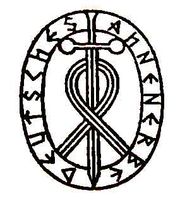
------------------------------------------------------------------------------
------------------------------------------------------------------------------
the origins of Runes
The middle-eastern biblical description of the phonic alphabet's (Phoenecian root) division into the many spoken language-branches of the Semitic middle-eastern language family-tree describes it as having originally occured shortly after the world-flood that destroyed Atlantis (called, in Genesis, the city of Enoch), at the beginning of the Babylonian Empire from the unification of northern Akkad and southern Sumer between the Tigris and Euphrates rivers. In Genesis we are told of the building of the Tower of Babel, and of the subsequent "confusion of the tongues." This mythology establishes the division of the alphabet into languages to the east of Babylon, with the 50 letters of Indus Sanskrit, and to the west with the 27 "monoliteral" Hieroglyphics of Egypt as having derived from the 36 letters of pre-Babylonian "Ugaritic" cuneiform, the earliest known ante-deluvial alphabets known of including "linear-A" and "-B."
No sooner than Sanskrit, Hieroglyphics and Cuneiform could the Runes themselves be dated. This is because, whether or not the meinheirs of Europe were raised before or after the world-flood, it is widely believed that the carved inscriptions on them, from which we date the eldest form of definitively "Runic" alphabetic writing, could only have been etched into the stones after the flood, on the grounds that they would have been worn away by the waters. Of course, this is hog-wash and poppy-cock out the wazoo. Consider the Rongo-Rongo writing of Easter Island - it was obviously written on them by the same people who erected the megalithic stone heads there. The fact that edifaces such as England's Stone Henge differ from the upright but un-hewn meinheirs is demonstrated by the fact the meinheirs are inscribed but Stone Henge was not, however it is equally obvious that the same technique of aligning the sites to annual astronomical observations was used ubiquitously throughout.
Contemporary, and contrary, to HP Blavatsky's proposal of the theory that the meinheirs, Henges and megalithic heads were raised by the "Nefilim" (lit. Giants) of before the Biblical world-flood, Charles Darwin proved genetic characteristics could be used to trace the migration routes of species over epochs and of certain physical traits in races over the eras. It was because of Blavatsky's self-professed occultism that her theory came to weigh such heavy influence over Darwin's discovery, and why there remains now, some hundred years later, controversy on the issue of whether Darwinian "Evolution" or Christian "Creationism" should be taught in public schools.
Darwin's original theory of genetic traits was, by the time Watson and Crick discovered the molecular structure of DNA, so polluted by Blavatsky's pseudo-mythology in the public mind that the discovery of light-skinned, red-haired mummies in Mongolia and southern Siberia, just north of the Tibetan Himalyas, led to such a swell of Nationalist Patriotism in Germany following the Wheimar Treaty ending WWI that it was successfully used to turn the public's eye blind during the Holocaust. In truth, from their origins in the southern hemisphere, homo sapiens migrated in all directions continually, spreading from Africa and Australia into the Middle East and southern Asia, and from there to souhern and northern Europe and to first the coasts and then the mainlands of North and South America. Throughout all these times the biological language of genetics has migrated and dispersed throughout all these lands along with us.
Thus, the notion of "race" should be considered a concept applicable only to ancient peoples of the past, such as the blue Aryan Vedics of the Indus river valley, the bald Semites of the Middle East and the dark haired Egyptian Africans. The even older Aborginal and dark-skinned race should be considered the same in Africa and Australia. The idea of race should have ended with the Indo-European invasion of the Americas. By that point, the Indians had spread through China into the Siberian steppes (the Monogloid race), while the Semites of the Middle east had migrated into Southern Europe to mix with the race of caucasions who had migrated from northern Asia into northern Europe across the Caucasoid mountains.
The fact that the proto-Caucasoid Asians were the Aryan Vedics of India and that the proto-Mongoloid southern Asians became the mainland north Americans should not be a matter considered on the grounds of race, but on language. In the same way, the Australian Aborginies and the African tribespeople should be thought of as having once been two seperate migrations of a single species that dwelt in Antarctica, before it became glaciated, during the time of the last north hemispheric ice-age. So we see that the division first between the two routes of one species, followed by the division among the different early settlements of equatorial Eurasians of their formerly single language into various phonic alphabets, followed most recently by the notion of nationalistic "root" races (the "ancient" feud between so-called "Aryan" caucasians and the Hebrew Semites having panned out into total caucasian xenophobia in the formerly European colonial north America), has led from one degeneration and confusion to another, until finally all is chaos, and we forget the proper time of the coming of the next northern hemisphere ice-age.
But let us remember the original source of the Runes not as a written phonic language but in the mythology of their own creators, the Indo-Europeans. According to them, the Runes were first seen by Odin in the reflection of the moon in a puddle below him as he hung upside down from Ygdrassil, the "world-tree" of Druid mythology. It is far more likely the Druids created the Runes to inscribe the Meinheirs and erected Stone Henge themselves, however, as I have now illustrated, the origins of the Runes, as well as of many other ancient alphabets, remains as much a mystery as the Origin of Species so long as the Creation of God is confused with the racism of its proponents.
Although it is believed the inverted (or "unlucky") crooked-spiral cross motif was authentically a design of Adolph Hitler, it is known that the reverse of this appeared first on Tibetan Buddhist monastery wall-paintings several hundred years before first appearing in Celtic Ireland. Both places the triskele, or triple-cross / spiral, and the swastika, or quadruple-cross / spiral are both considered symbols of the Milky Way galaxy as seen from above or below one of its poles. This symbol is also equivalent to the double- cross / spiral of Yin Yang and Hunab Khu. Similar symbols are the spiral and maze patterns that date back to the places of earliest habitations in Australia, Asia, Europe, and North America, so it should be considered an innate symbol in the original alphabet used in Antarctica. Its correct pronunciation, however, has obviously since been lost. Instead now it is called "Thule."
That is why most post-Rennaissance alphabet forms have been retrograde to the trend of variegation and bifurcation. They attempt to simplify rather than complicate. This is occuring as the galactic cycle draws nearer to completing one full orbit around from the times of Atlantis in Antarctica.
the 18 Armanic Runes of Guido von List
In addition to the self-styled "Theosophy" of Blavatsky, the Nazi's also adopted the Rune Lore of Guido Von List. Von List had simplified the 24 letter Younger Futhark alphabet into an 18 letter alphabet he called "Armanen." He created the shapes of these Runish letters based on the refractions of light through such hexagonal forming crystals as quartz. A similar system has been more recently proven true for the letters of the Hebrew alphabet as shadows from the spiral shape of a ram's horn. While the Hebrew letter shadow-shapes can account for the additional doubles or the finals, the idea behind von List's Armanic was to narrow down the number of Runes as much as possible, and to that end List noted in his work, The Secret of the Runes, that the original Runic alphabet "consisted of sixteen symbols in ancient times."
The Armanen consists of some 18 intersections, all of which can be extracted from the six line hexagon surrounding a central triple cross. In this diagram from page 109 from Nigel Pennick's work Magical Alphabets, 1992, Weiser, we see the 18 individual runes arranged in a regular pattern around the central hexagram, and that in turn surrounds the inner-circle around the Chi-Rho motif of early Christianity. At the bottom of the diagram are given the 18 Runes of the Armanen.
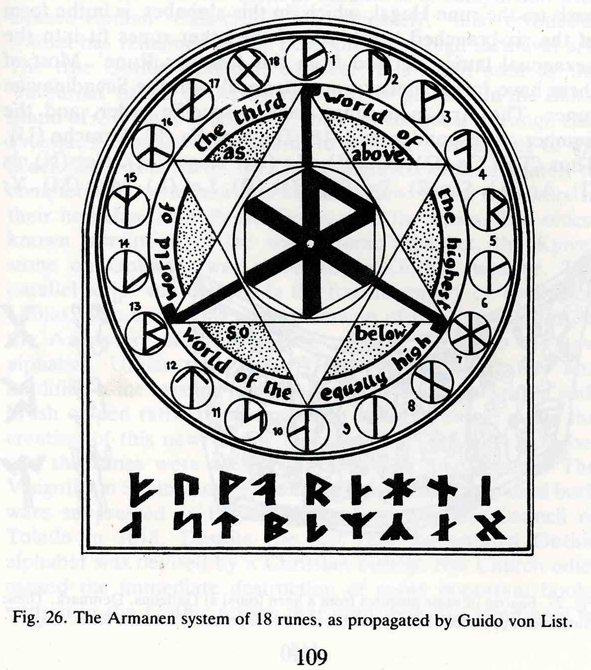
In this diagram we can find no particular significance to their specific order as shapes, and thus must presume their order as proceeding in the standard order of the Younger Futhark. However, I would propose there to be a higher order of the insignias' placement than given by the standard phoenetic ordering of the Younger Futhark that can be produced as an alternative combination of the letter-shapes on this same basic pattern. In other words, if the "board" is "tyled" differently, there would be more meaningful relationships between the shapes of the individual letters that would become apparent, however the best way to deduce this would be to place a consecutive sized hexagonal quartz crystal on the center of the above diagram and then shine a light through it. The most significant aspect of the above pattern is the nascent combination of polar, cardinal and zodiacal attributes (2+4+12=18). However, that much at least is inherent to the geometry of the hexagon itself, and is not a by-product of optical refraction gradients.
It should be noted that the study of the Armanic Runes of Guido von List can be considered seriously now because of the mythology attached to it, propagated by von List's occult rival, Nazi SS Reichsfuhrer Heinrich Himmler's mentor Karl Maria Wiligut. According to Wiligut's mythology the planet Saturn, home of the Hyporboreans, was a burnt-out star that was once the center of our solar system. The name of Wiligut's mythological religion was Irminenschaft, and Wiligut himself was among the members of Ahnenerbe, the inner-core of the Nazi occultists. Because Wiligut distanced himself from the less radical von List, we can now discuss Armanic Runes devoid almost entirely of all but the feighntest taint of Hitler. It should also be noted, by way of discounting Irmin-ism, that the Secret Doctrine describes the spans of seven planets reigning as suns (the seven Rays).
Now I'd like to show you my own pattern of arrangement for the 18 Armanic Runes. Instead of being based on the inherent hexagonal shape behind each individual letter, thus rendering a circular arrangement, I have "tyled" the "board" with squares whose numbers and letters all correspond to those in the previous diagram. Here is my own arrangement of the Armanic Runes:
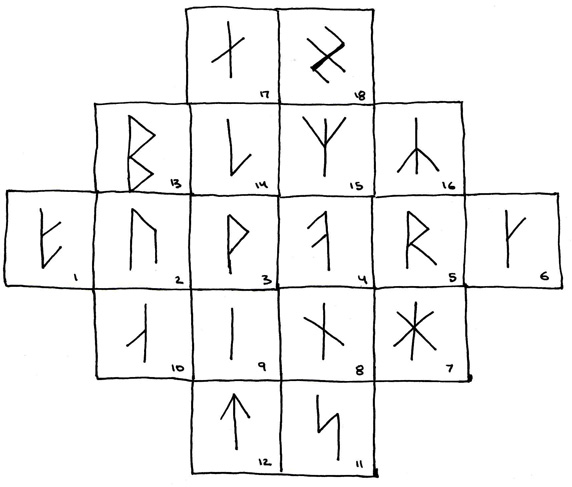
The reason for the placement of the phoentic letters on the squares is simple: the first six letters spell out FUDORK, ie. Futhark, the name of the traditional Runic alphabet. Therefore, they can fit across the horizontal row of squares in the middle. The six below and above then follow outward and from right to left. It should be duly noted, though, that this much of the ordering for my version of the Armanic system is more or less arbitrary, open to debate and subject to change for the better.
The reason for the use of this particular form of arrangement of the 18 squares, such that 2:4:6:4:2 = 6+6+6 = 18, is much more complex, however, and will involve other systems of Runes as well as ancient languages from the entire early world. What we are about to begin embarking on is an unfolding of these diagonal (diamond) squares along a fractal pattern of expansion such that, as the overall arrangement rotates one way, the number of interior squares increases by counter-rotating the other way around. However, before we can consider the next iteration in this unfolding and, ultimately, spiralling pattern of expansion, we have to come back, again, to the Elder Futhark of 24 Runes from the more traditional, circular arrangement.
the 24 Elder Futhark
This diagram, from page 121 of Pennick, ibid, displays the 24 Elder Futhark as each one a "half-hour" mark on a standard base-12 clock:
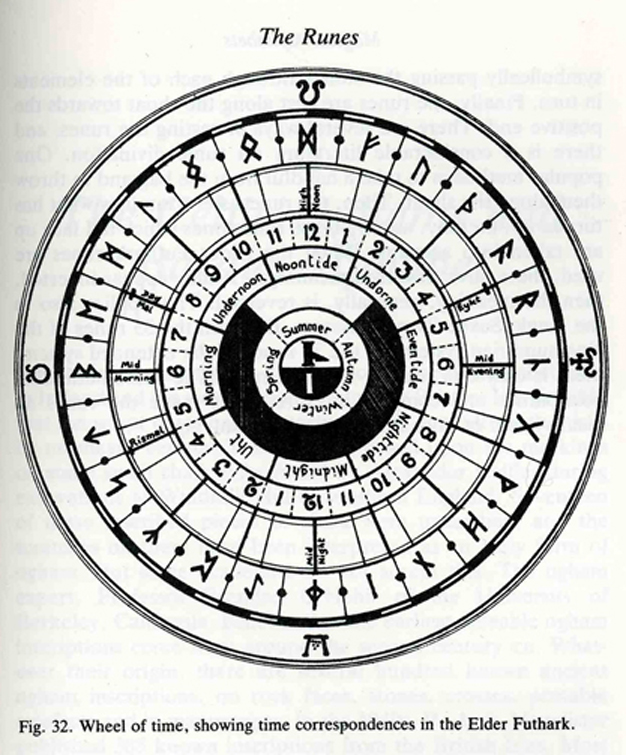
Note in this diagram that the interior-most circle, divided between light above and dark below, would rotate fastest, followed by the second circle out from that, of the tides, followed by the next circle out from that, the 12 "relative" solar months per year, followed next by the outermost circle of the four cardinal zodiac signs of the seasons per aeon, then by the Runes, then by the clock circle, and finally by the seasons surrounding the central circle of day and night. The circle separating the tide cycle from the seasons above day and night is four colours: gold, garnet, burnt umbre and drab olive, and represents Malkuth in a manner the Golden Dawn called the "Dragon arrangements" that thus communicate the entire cosmic-clock (or moving calendar) between the cards of Tarot, the so-called "Wheel of Fates."
Having considered this model of measurement of "cosmic" spans of time, let us return to the unfolding (diamond) squares model I presented for the 18 letters of the Armanen of von List. In the next diagram, I show the manner of interior redistribution of the letters as they occupy positions on a tyling board that has been rotated exteriorly by 90 degrees, whereby each interior square has been rotated 180 degrees.
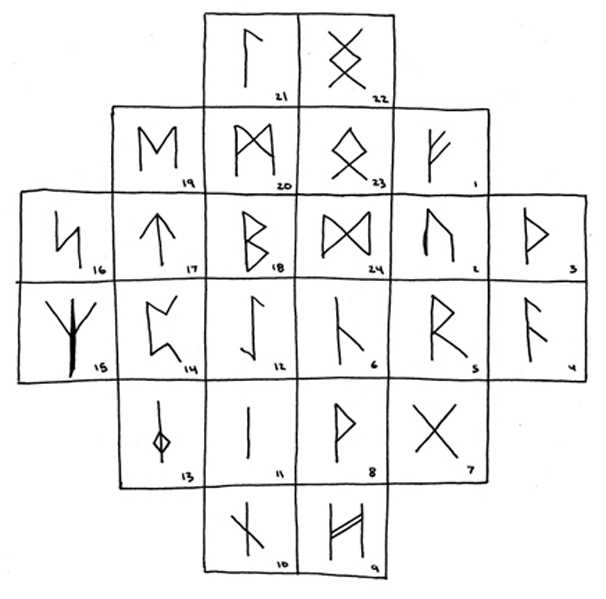
The result is that the letters now proceed to wrap around the outer rim of the (diamond) square configuration overall, zig-zagging in and out toward the central square and outward toward the medians of the (diamond) square's "sides." So we see that, as the larger (diamond) square rotates one way, each smaller component (diamond) square rotates the other, and that, as they do this, the entire system expands one way or contracts the other. This is actually due to a complex recombination method that I will explain in a moment.
For now, suffice it to say that this diagram represents the 24 letters of the Elder Futhark in the same arrangement as my (diamond) square arrangement diagram for the 18 Armanen of von List. The only difference is in degree and scale of complexity. In the 18 Armanic Runes we simply see a more concise and direct, less elaborate and complex, iteration of the same model upon which the 24 Elder Futhark Runes can be assembled. Now, there exists a further extrapolation of this "unfolding" system, comprised of 27 individual base-unit (diamond) squares. I'll also return to describe it but briefly in a moment, however now let it just be said that the Runic alphabet (known as the Agnaw) of 27 characters that accompanies this diagram provides an additional level of discerning proper ordering of the individual components of the base-24 Elder Futhark arrangement seen here.
Now, as to the "table of correspondences" that can be assembled on the base-24 "lattice" of the Elder Futhark in this "unfolding" arrangement, by comparison to the alphabet of the base-27 system above and the base-18 system below, may be derived a surprisingly wide variety of ancient languages later to become methods of divination. Considering the similitudes between the base-27 letter-language's symbols and the eight "double" trigrams of the I Ching, I was able to establish in one system a correspondence between each of the 27 letters with an equivalently structured trigram, and in a second system, built into the first, to place the 22 letters of the Hebrew alphabet that correspond to the 12 signs of the zodiac, the 7 planets and 3 of the 4 natural elements. I will leave it to the viewer to ascertain the order in which I have arranged these two systems relative to one another on the following diagram, however be aware in that the central "diamond" shaped idiograms (or diagonal "squares," each relative to the larger overall diamond-shaped, diagonal square pattern) and the I Ching trigrams are the only things necessarily fixed to one another in this diagram. The Elder Futhark attributions stand as before and my attribution for the order of the Hebrew and correspondent ideograms deserves revision, although still holding essentially sound as a rough working model.
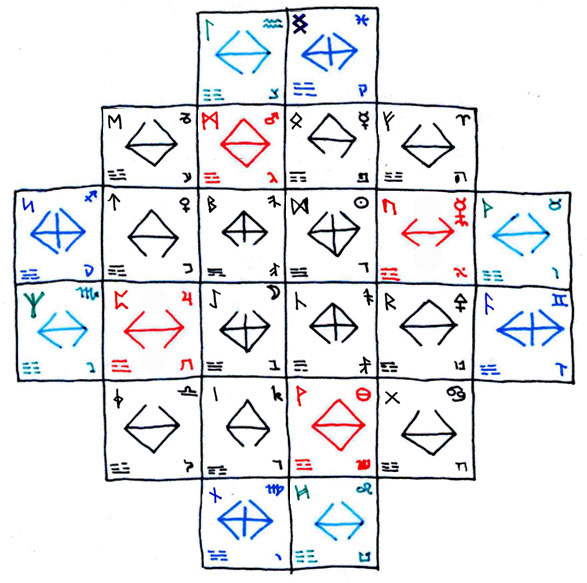
The process of folding and un-folding this model and the resultant interlocking yet obviously unique and each original forms of patterns among shapes that can be tesselated upon them is a way of unlocking the basic system by which all modern alphabets were created, each being formed by derivation or extrapolation upon every other. Just as the 3 in 4, the 4 in 5, the 5 in 6, the 6 in 7 in 8, so the 12 fit inside the 13, 13 in 16, 16 in 18, 18 in 22, 22 in 24, 24 in 25, 25 in 27, and so forth through 36, 50, 64, 72, 180 and 360. This is simply the material unfolding of a cube-root diaganol from one corner to another, and even this is merely a point at the center of its shadow, the hexagon.
In short, the base-18 unfolds into the base-24 via an intermediary state, the odd-numbered base-23. So, too, are 25 and 27 both odd-number base-systems, and so both demonstrate a form of stretching out the space between the interior (diamond) squares. Whereas the structures of even-numbered base units will always form a solid, (diamond) square pattern, the odd-number base systems will always form a vertical / horizontal cross pattern that essentially divides the diamond-shaped square across its diaganols. Confer this model for a base-25 system arrangement as an example of how to begin constructing the base-27 model. From the base-27 model the system of Runes called the Agnaw arises.
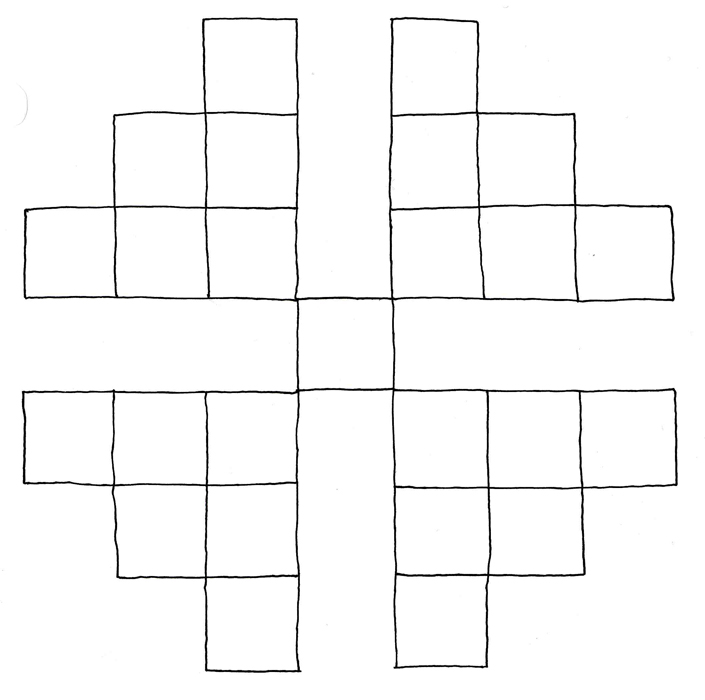
-ben
------------------------------------------------------------------------------
------------------------------------------------------------------------------
